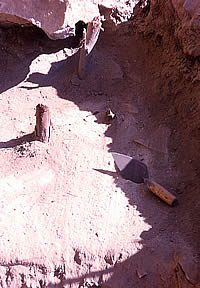
An L-shaped set of wooden posts exposed in the upper deposit at Coontail Spin is
thought to represent the outline of some sort of simple structure, perhaps a
windbreak, that abuts a large boulder (roof spall) near the front of the shelter
. Photo from ANRA-NPS Archives at TARL. |
| |
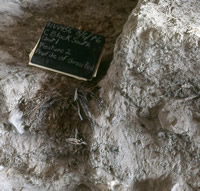
Remnants of a grass-lined pit that was probably a bed from Early Archaic deposits in Analysis Unit 5 or 5b.
TAMU Anthropology archives.
|
| |
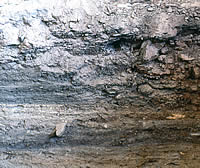
Profile section from latrine area showing paper-thin, urine-compacted lenses and coprolites. The coprolites can be seen in the upper right.
TAMU Anthropology archives.
|
| |
Over a hundred sandals and sandal fragments were recovered in the excavations spanning a sequence from the early part of the Early Archaic (perhaps 7,000 B.C.) to the Late Archaic (ca. A.D. 500). The Hinds research team put together the first chronological sequence of sandal types recovered from the Lower Pecos canyonlands. |
| |
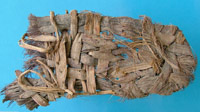
Biparallel warp frame style sandal typical of Late Archaic construction recovered from Analysis Unit 1.
TAMU Anthropology archives.
|

Bent frame style sandal, also common in Late Archaic deposits in Analysis Unit 1.
TAMU Anthropology archives. |
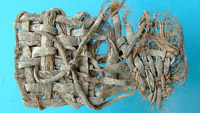
Double frame style sandal. This style was recovered from Analysis Units 5-7.
TAMU Anthropology archives.
|
| |
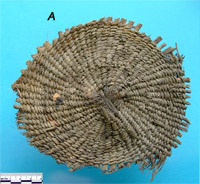
Bottom section of a twined basket. TAMU Anthropology archives. Enlarge to see reverse.
|
| |
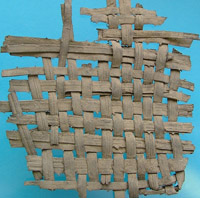
Simple "one over one" checker weave mat of sotol leaves.
TAMU Anthropology archives. |
| |
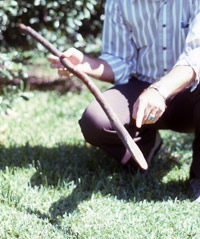
A superb example of a digging stick found in Hinds Cave by Fred Speck. Note the beveled bit end of the stick.
TAMU Anthropology archives. |
| |
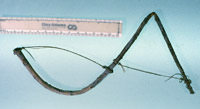
The function of this bent stick tied with a cord is unknown. TAMU Anthropology archives. |
| |
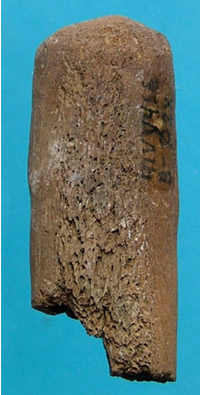
A fragment of an artifact made of deer antler.
TAMU Anthropology archives. |
| |
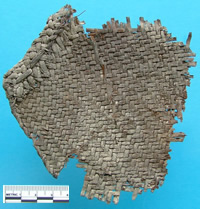
"Two over, two under" checker weave mat with stitched edge.
TAMU Anthropology archives. |
| |
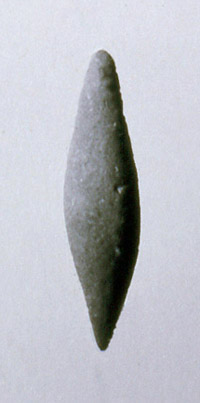
Clay figurine from Hinds Cave that may represent a male figure. TAMU Anthropology archives. |
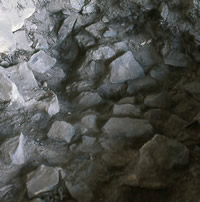
Dense concentration of burned rock such as this are tell-tale signs of repeated uses of earth ovens within Hinds Cave. The cave’s interior provided a dry retreat for preparing foods during wet periods. TAMU Anthropology archives. |
| |
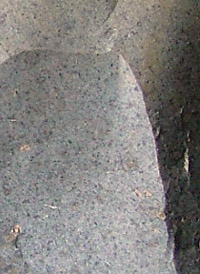
Closeup of gray speckled Edwards chert that outcrops below Hinds Cave.
TAMU Anthropology archives. |
| |
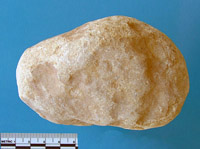
Limestone pebbles were sometimes used as hammerstones. TAMU Anthropology archives. |
| |
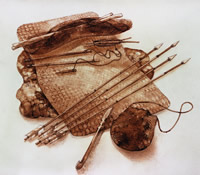
An artist’s rendering of an assemblage of tools and weapons that may have outfitted an Archaic hunter in the Lower Pecos. Image courtesy of the Witte Museum. |
| |
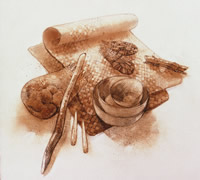
Women had their own tools appropriate for gathering and food preparation. This artist’s rendering shows a digging stick, bone awls, agave knive, basket containers, sandals, and woven mats or petates. TAMU Anthropology archives. |
| |
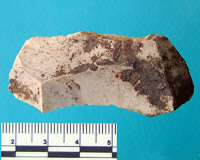
Dirty tools such as this distal end of a blade provided forensic evidence of use. The once sticky substance adhering to the surface preserved plant fibers, phytoliths, and rodent hair.
TAMU Anthropology archives. |
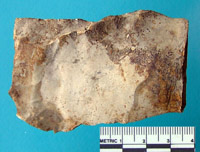
Large flake used as a knife blade. Organic residue on this specimen consisted of phytoliths and plant fibers hinting that it may have been used to cut the leaves off of desert succulents.
TAMU Anthropology archives. |
| |
We decided to scrape off bits of the residue to see what Rick could identify under high magnification. The results were rather astounding. Rick identified the epidermis (outer skin) of sotol, lechuguilla, and yucca adhering to various tools. In addition, he recognized the starch grains from plants, plant phytoliths, plant fibers, and animal hair from rabbits and rodents.
Harry Shafer |
| |
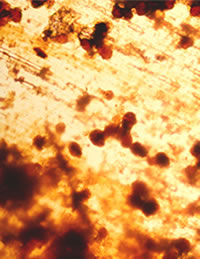
Tiny fragments of lechuguilla epidermis adhering to the surface of a knife blade left clear evidence that the tool was used to cut agave, among other things.
TAMU Anthropology archives. |
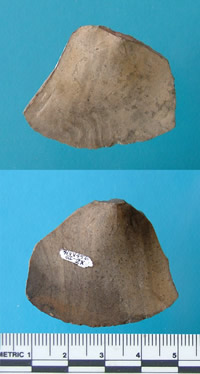
Sequent flake knife blades Area G Analysis
Unit 8. These tools were ulu-style knife blades used to cut
the leaves from desert succulents and butcher animals. TAMU
Anthropology archives. |
|
Housekeeping
Archeological evidence of how space was structured within a prehistoric site is rare except in those cultures that built formal houses such as the adobe pueblos of the American Southwest. Most hunter-gatherers seem to have built only the flimsiest of houses—little more than wind breaks and brush huts. They did, however, take advantage of much more substantial natural houses—rockshelters. Hinds Cave can be viewed literally as a house with structured compartments: living areas, sleeping areas, cooking areas, and latrines. Of course, the sheltered space was not used the same way each time and not enough of the site was excavated to allow us to accurately reconstruct the complete layout of the house at any one point in time. Nonethless, some patterns were clear.
Semi-circular patterns of wooden stakes thought to represent simple wind blocks or partitions have been documented at several dry shelters in the Lower Pecos. These partitions probably afforded protection against cold winds and perhaps a bit of privacy. Further evidence of housekeeping was uncovered at Hinds Cave including floor coverings, beds, and latrines.
Apparent floor coverings were documented in several places in Hinds Cave. Prickly pear pads, oak leaves, and grass were all deposited in layers that suggest the intent was to cover the dusty floor of the cave. Several apparent floors of prickly pear pads were found in the main habitation area of the cave dating to about 6400 B.C., during the Early Archaic period. These rather extensive floors were composed of prickly pear pads and stems, with spines removed, placed over an area at least 4.5 meters by 3 meters. One floor reached a thickness of nearly 15 centimeters (6 inches) in one area, but most floor covering was about two pads thick.
Evidence of additional flooring dating to the Late Archaic was noted in the form of lenses of live oak leaves. Live oaks once grew in the canyon; typically they lose their leaves in March before flowering. The ground beneath the trees is carpeted with fallen leaves. Apparently the occupants of Hinds Cave would periodically gather these leaves and use them, like the prickly pear, to floor the cave. The same appears to have been done using bunches of tall grasses.
Along the back wall and extending into the living areas in the central part of the shelter were traces of numerous pits lined with twigs and grasses. These pits are believed to be the actual beds in which the occupants slept. Beds were constructed by excavating a shallow pit, lining it with green twigs and leaves. A layer of grass was added over this springy layer, along with mat fragments and worn out sandals. Another layer of grass was placed over this for insulation. These little beds were small; some were circular and some were oval, no more than a meter or so long and three-fourths of a meter across. In other words, the favored sleeping position was not extended and lying flat, but rather flexed in the fetal position, probably to conserve body heat. After all, there is little evidence they had much in the way of clothing to keep them warm. During very cold nights, warming fires were probably built near the beds and rocks may have been heated to generate heat near the bed.
On the slope beyond the south of the living area and along the west wall was a latrine area. This latrine area was used time after time for thousands of years. There were also some smaller, short-term latrines against the walls in other areas of the shelter.
Dress
There was little recognizable evidence of clothing at Hinds Cave. One interesting exception was the remains of a rabbit fur robe—fragments of rabbit fur that had been twisted around a cord framework. More or less intact rabbit fur robes have been recovered from several area rockshelters. Otherwise, there wasn’t much found at Hinds Cave that could have been used to cover up with. Based on early historic accounts by Europeans of encounters with sparsely dressed hunting and gathering peoples in northern Mexico and the American Southwest, we would guess that most Hinds Cave inhabitants rarely wore much clothing except during inclement weather. Grass fringe skirts and deer skin fringe skirts have been recovered from dry caves in the region.
The most common and necessary item of dress was footwear. Sharp, eroded limestone surfaces abounded in the canyons as did sun-heated rocks and many thorny plants, making walking without protective footwear treacherous. The people of Hinds Cave fashioned thong-like sandals with padded soles and straps made from lechuguilla and yucca fibers. Over a hundred sandals and sandal fragments were recovered in the excavations spanning a sequence from the early part of the Early Archaic (perhaps 7,000 B.C.) to the Late Archaic (ca. A.D. 500). The Hinds research team put together the first chronological sequence of sandal types recovered from the Lower Pecos canyonlands.
Tools and Utensils
Tools and utensils were ingeniously and often expediently made from raw materials at hand. Plant fibers and woods were used in myriad ways. Yucca and lechuguilla fiber and grass stems were used to weave twined baskets. These tightly woven trays and bowls varied in size and depth and were used as containers for winnowing, parching, carrying, and serving. Yucca leaves were also used to weave straps and tumplines for carrying loaded baskets. Net bags woven of twisted strings made of yucca and lechuguilla fibers were used for carrying lighter loads. Expedient and disposable baskets were made of sotol leaves produced by trimming the leaves off of sotol bulbs, which were then transported to earth ovens (both outside and inside the cave).
Making string must have been a common leisure activity since string was used to make many different things. Simple string was twisted in an S or Z twist and ranged in thickness from very fine strings composed of only a few fibers to almost rope-size. Strings were used to manufacture hunting nets, fishing nets, net bags, carrying bags, snares, garments, and many other things. Simple cords or straps were made by stripping yucca leaves and simply tying knots to secure the burdens being carried.
Plant leaves, especially sotol, yucca, and lechuguilla, were used to weave a variety of textiles. The most commonly found textile fragments were of simple checker-weave mats. In Mexico these are called petates and are still woven by such groups as the Pamé in northern Mexico, descendents of the hunters and gatherers of northern Mexico. Petates are rectangular mats used in many ways, from covering floors and structures, to carrying belongings, lining bedding, preparing food, making baskets, and even to wrapping corpses for burial. Other mats may be more finely woven and also served many different purposes, including those listed above.
The Hinds Cave materials also provide a glimpse of the wooden tools and technology used by the long-ago occupants. Digging sticks were made of hardwood limbs or small trees and had either pointed or spatulate ends. While such tools must have been carried by every woman on gathering expeditions, the term “digging stick” is a bit misleading. Use-wear patterns and common sense dictates that hardwood sticks would have been useful for digging as well as prying, poking, hitting, fending, and much more. And there is little reason to think that only adult women used digging sticks—anyone big enough to carry one must have found them indispensable at times.
There were also traces of weaponry at Hinds Cave. Fragments of throwing sticks or atlatls, discarded hardwood foreshafts, and the debris from foreshaft manufacture were among the items recovered. Also found was the rear end of an atlatl dart made of lechuguilla stalk.
A few artifacts were recovered that reflect personal aspects of Archaic culture. A wooden comb found by collector Fred Speck is stained with ochre. This suggests that hair may have been colored red with ochre under certain circumstances, perhaps to enhance their appearance during social gatherings.
Bone and Shell Tools
Bone artifacts were found throughout the Archaic deposits at Hinds Cave. Most were fashioned from the bones and antlers of white-tailed deer. The most common tool form was the awl, a pointed implement used for weaving and probably many other tasks requiring a strong pointed tool. The awls were mostly made of split deer bones, especially from deer metapodial, a hard bone in the foot. The relatively thin and sharply pointed bone implements were probably used mainly for basket weaving, but the thick awls of deer metapodials may have been used for a multitude of things. These handy tools were probably carried into the field on gathering expeditions and used to split yucca or sotol leaves, and perhaps even to open the hearts of the plants. The polish on the tips of several of the awls suggests use against green desert succulents. The common occurrence of bone awls suggests these were indeed parts of everyday tool kits, perhaps belonging to both sexes.
There were also several slender, very sharp bone needles, at least one of which has a grooved blunt end probably used to tie plant fibers for sewing. Some of the mats have sewn edges. There is no evidence of tailored sewn clothes, but needles and fiber must have been useful for binding a variety of objects.
Deer antlers were a common source of raw material for a variety of tools, including possible punches or billets for flint knapping and antler tines for pressure flaking tools. Skulls of deer with antlers attached may have been used for ritual costumes or hunting disguises, though none were found at Hinds Cave.
River mussel shells made natural small containers such as spoons or ladles. The sharp edge of certain species of mussel shell also were useful for expedient cutting or scraping tools, and the shell itself was often used as a source for beads or other ornaments. Although a few worked mussel shells were found at Hinds Cave, no shell beads or ornaments were recovered. These have been found at other rockshelters in the region.
Clay Figurines
Three unfired clay figurines were found clustered together by Fred Speck (the student-collector who brought the site to the attention of archeologists) in a fiber layer containing sandals, matting, and string. Speck recalled that the figurines came from an ashy deposit, an observation confirmed by ash particles adhering to the objects. Since the artifacts were not fired, the ash may indicate some sort of ritual deposit.
The figurines were made of a brown silty clay and were fashioned simply by rolling the clay between the palm of the hands. Two of the figurines are assumed to depict females based on apparent mammary appendages (one is missing on one specimen). The dating of the figurines is speculative; Speck recovered Val Verde and Marcos dart points in the general vicinity of the cache, and on that basis, we assume the figurines probably date to the Late Archaic.
Clay figurines have been recovered from other dry shelters in the Lower Pecos Canyolands. Similar figurines ocurr in the American Southwest and Great Basin. Among those from the Lower Pecos, most are female and are often headless and are either unfired, or minimally hardened from firing. Surface embellishments include mammary appendages, incised or painted decorations. The function of these interesting artifacts is unknown, but it does seem likely that they are symbolic human representations used in ritual.
Stone Artifacts
The most common stone artifact at Hinds and most other prehistoric sites in the region is the cooking stone, known to most archeologists as burned rocks or fire-cracked rocks. Hot limestone rocks serve as thermal reservoirs—they hold and release heat gradually—allowing prehistoric cooks to build effective earth ovens. Such ovens, so named because layers of earth are used to hold in the heat, were used for baking the bulbs of lechuguilla and sotol as well as prickly pear pads and other plants. Limestone rocks serve well as cooking stones, but they don’t last long. Each heating and cooling cycle results in cracked rocks. After a few cycles, cooking stones broke into fist-sized and smaller fragments that were discarded. Literally tons of limestone slabs were carried into the cave for such uses. Consequently, discarded fire-cracked rock fragments formed the bulk of the non-perishable deposits at the site.
Chert (commonly but incorrectly known as flint) was the other indispensable rock type, essential because it breaks like glass and could be fashioned into many different chipped stone tools. The Edwards Limestone formation into which the side canyon has been cut contains at least two separate seams of chert. One distinctive type is a thin layer of dark gray with white specks. Hinds Cave inhabitants frequently exploited this and other chert sources to manufacture their chipped stone tools. The most commonly encountered stone tools were projectile points and simple flake tools used as knives and scrapers. Other tools included bifacial knives and chopping tools. Freshly struck flakes were often used as expedient knives and scrapers.
Limestone cobbles were used as hammerstones to remove flakes form cores. Several of those found in the Late Archaic deposits at Hinds are battered on the ends from direct contact with chert. Antler punches and hammers may also have been used to thin and shape points as well.
The projectile points from Hinds Cave tell several stories. All of them are dart points once attached (hafted) to light spears known as darts that were hurled with the aid of atlatls (spear-throwers). These weapons used mainly for hunting deer to judge from the types of bones found at the site. Archeologist value dart points because they are useful as time markers. So long as the dart point stem is reasonably intact, we can estimate its approximate age. Stem form and shape is based on how the flint knapper learned to make and haft points. Over time and across space, different groups made different stem forms and used other nuances in finishing a point (such as beveling the stem edge or twisting the blade edge). These stylistic traits allow archeologists to place point styles in time and space, and thereby use points as approximate dating tools during the course of excavation and analysis.
When men went on the hunt, they carried with them net bags containing a repair kit. This kit included partially finished bifaces which could be finished into points as needed, large thin flakes which could be used as knives or other expedient tools, sinew, hammer stone, antler punches, antler pressure flaking tools, and medicinal items for use as hunting magic or medicine.
Points used in the hunt get damaged as the darts miss their target, and this happed far more often that not. If the tip was only slightly damaged, the hunter would carry the tools along to repair such damaged tips by re-chipping the damaged area. This retooling happened often and sometimes to the extent that when the opportunity came to replace the point, it was discarded and a new one inserted into the end of the dart fore-shaft. Many of the points found at Hinds Cave show evidence of impact damage and often field repair as well. Many also show signs of having been used also as knives.
Women had their tool kits too. These included a digging stick, carrying baskets, hafted agave knives, and probably tools needed to construct expedient baskets (such as bone awls) or to repair the agave knives (a flaking tool of some kind, or perhaps even spare knife blades).
Dirty Tools
One of the most informative products of the Hinds Cave excavations was the recovery of dirty tools—stone tools used in such a way that they became dirty from the juices and organic debris from cutting plants, butchering animals, menial tasks, and dirty hands. We realized that these dirty tools could tell unequivocal stories about their use, how they were used and what they were used to cut or scrape. Examples were pulled from the collection and analyzed for traces of identifiable organic substances adhering to their surfaces. The results were not only surprisingly good, but have subsequently changed our thinking with regards to the uses for a class of uniface tools traditionally called “side scrapers.”
In the mid-1970s, Richard (Rick) Holloway and I (Harry Shafer) were well aware of efforts to identify the organic residue on stone tools from the American Southwest. Thinking the approach might work with tools from Hinds Cave, we selected a group of dirty uniface tools and flakes to perform our experiments. We had initially planned to use dyes to detect plant or animal residue but observed actual plant debris on the tools under the microscope. Rick was a graduate student with a background in botany and was working in the Ethnobotany Laboratory in the Anthropology Department at Texas A&M at the time. We decided to scrape off bits of the residue to see what Rick could identify under high magnification. The results were rather astounding. Rick identified the epidermis (outer skin) of sotol, lechuguilla, and yucca adhering to various tools. In addition, he recognized the starch grains from plants, plant phytoliths, plant fibers, and animal hair from rabbits and rodents.
Translating the use-wear information to tool form and use was also revealing. It is quite clear from the patterning of the organic build-up that the primary use motion was indeed one of cutting and not scraping. This cutting motion was consistent with the harvesting patterns for sotol and lechuguilla, the leaf bases of which clearly showed they were cut with sharp knives.
In the 1986 book Ancient Texans, Rockart and Lifeways along the Lower Pecos, I called the oval flake tools “ulu-hafted knives” using the Eskimo term for knives with crescent-shaped blades that women traditionally used. My reasoning is that harvesting sotol and lechuguilla, butchering animals, and other such tasks were roles usually attributed to women in the ethnographic literature of Native Americans including those in the nearby American Southwest. I called the ulu-hafted knives “women’s knives” to place an emphasis on the different roles men and women played in basic subsistence activities. Conversely, I consider hafted dart points as the likely candidates for “men’s knives.”
The ulu-hafted knife form is probably as common, if not more so, than projectile points in Lower Pecos Canyonlands. These were oval flakes struck from the side of a core to create a broad flake terminating with a very sharp edge. One technique was to remove a series of such flakes in a sequence. Sequent flakes have the bulb of percussion on one face and a negative bulb on the opposite side of the striking platform. The bulbar end of the flake was often thinned bifacially to facilitate hafting. The flakes were hafted in a slot cut in the middle of a stick handle. This knife form is equivalent to the ulu knife used by Eskimos in modern and ancient times. It is also similar to an agave knife used among the Pima and other groups in the American Southwest. Organic debris built up against the haft, leaving a linear pattern of residue on the flake once it was ejected from the haft. This pattern of reside was observed on examples from Hinds Cave.
Similar artifacts have been given the folk term, "side scraper," by Texas archeologists for much of the 20th century. This technical term has no factual basis with regards to known ethnographic examples. In other words, there is no such formal tool as a side scraper. Expedient flakes were occasionally used to scrape plant materials at Hinds Cave, but these were not hafted tools nor were they used in a consistent way.
I prefer the term sequent flake knife for ulu-style hafted knife blades. Examples observed from Hinds Cave, Eagle Cave, Shumla Caves, Coontail Spin, and other sites in the Lower Pecos region have often strongly beveled unifacial edges. Opposite the beveled edge one can often see a sheen created by repeated contact against plants that have high silica content, such as the phytolyths in sotol, lechuguilla, yucca, prickly pear, and grasses. This polish, often referred to as “sickle sheen,” is common in places world-wide where sharp-edge stone tools are used to cut fibrous plants. Organic residue analyses from Hinds Cave have clearly demonstrated that the oval, unifacially retouched tools from the Lower Pecos region were indeed knives and not scrapers. The residue build-up and retouch patterns show how they were hafted. Similarly hafted examples of knives have been recovered from several localities in southwest and Trans-Pecos regions of the state.
The antiquity of sequent flake knives is also revealing. The largest sample of these tools at Hinds Cave was recovered from Early Archaic deposits dating to approximately 5,000-6,000 B.C. I have also seen comparable examples in Folsom and Clovis assemblages described as “side scrapers” which suggest to me that the ulu-style haft has been around throughout prehistory in Texas but not recognized by archeologists. At Hinds cave we noted that the knife blades became less “formalized” through time. The Early Archaic sequent flake style predominated early in the Archaic, but the less formalized oval side-struck flake was the primary style in the Middle and Late Archaic. |
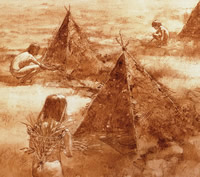
Artist’s rendering of an Archaic band in an outdoor campsite somewhere in the Lower Pecos. Image courtesy of the Witte Museum.
|
| |
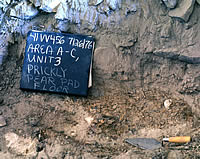
Prickly Pear Pad floor exposed in Trench A-C, Unit 3. The thorns had been singed off the pads, presumably to make them safer to use to cover the shelter floor and hold down cave dust, a constant problem in the dry rockshelters of the Lower Pecos Canyonlands. TAMU Anthropology archives.
|
| |
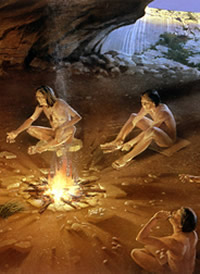
Artist’s rendering of an evening campfire and meal at a Lower Pecos rockshelter. Image courtesy of the Witte Museum. |
| |
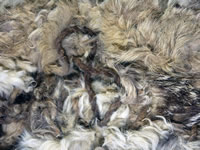
With a lack of animal skins to make clothing, the people at Hinds Cave made the most of jackrabbit skins by cutting them into strips and weaving them into a net framework to make a rabbit fur blanket. This example from a West Texas shelter illustrates the type of blankets used during cold weather. TARL Collections, Photo by Steve Black. |
| |
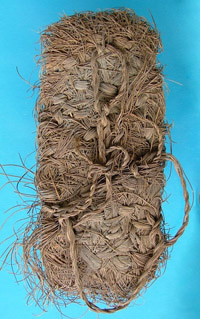
Early Archaic style sandal from Analysis Unit 7 of shredded fiber held in shape by horizontal rows of stitching.
TAMU Anthropology archives.
|
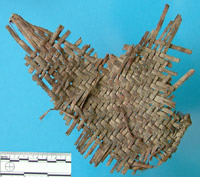
"Two over, two under" checker weave mat fragment. TAMU Anthropology archives.
|
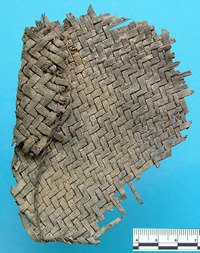
Mat fragment with reinforced edge. TAMU Anthropology archives.
|
| |

Proximal end of the Speck digging stick showing the polished and splintered end.
TAMU Anthropology archives.
|

Exterior of the Speck digging stick distal end showing the scratches and polish from use.
TAMU Anthropology archives. |
| |
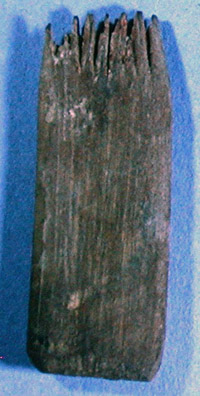
Wooden comb from the Speck collection with traces of red ochre. |
| |

Bone awl made of a deer metapidial with traces of organic residue probably from splitting the leaves of desert succulents.
TAMU Anthropology archives. |

Bone pin or needle probably used in stitching and sewing baskets.
TAMU Anthropology archives. |

Small bone awl probably used for spltting leaves, stitching and sewing.
TAMU Anthropology archives. |

Bone implement of jackrabbit? bone, TAMU Anthropology archives. |
| |
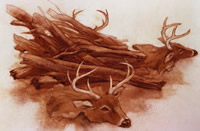
Artist’s rendering of a ritual deposit in which antlered deer heads were used. Image courtesy of the Witte Museum |
| |
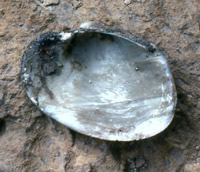
The large mussel shell was found cached in a wall niche at the rear of the cave.
TAMU Anthropology archives. |
| |
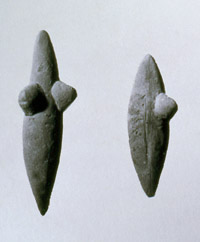
Fred Speck, Jr. found this cache of small clay figurines made by rolling silty clay between the palms. We do not know if these items were used as children's toys or for ritual purposes. TAMU Anthropology archives. |
The most common stone artifact at Hinds and most other prehistoric sites in the region is the cooking stone, known to most archeologists as burned rocks or fire-cracked rocks. |
| |
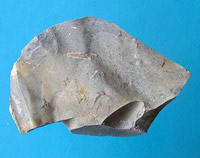
Flake tool made of gray speckled Edwards chert found in the canyon below the cave. TAMU Anthropology archives. |

Dart points were among the most common formal tools recovered in the excavations. The two Bandy type points (right and left) were from Analysis Units 7 and 8, and among the earliest found in the cave. TAMU Anthropology archives. |
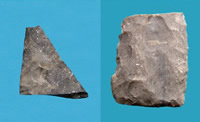
These broken bifaces were the products of manufacturing failures attesting to the fact that Hinds Cave occupants often manufactured and refurbished their tool kits at the site. TAMU Anthropology archives. |

Chronological sequence of projectile points from Hinds Cave. From top to bottom (and left to right), the six rows are as follows: Late Prehistoric arrow points, Late Archaic dart points (two Ensor, Frio), late Middle Archaic (Langtry, two Val Verde), early Middle Archaic (two Pandale performs, two Pandale), Early Archaic (two Bandy, Early Barbed); and Late Paleoindian (Golondrina). Relative scale approximate; the Golondrina point is about 7 centimeters (2.75 inches) long. |
| |
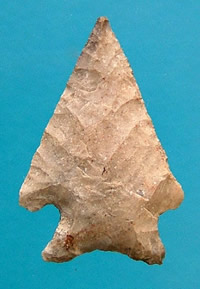
Bandy type dart point; note oblique pressure flaking from resharpening the blade. TAMU Anthropology archives. |
| |
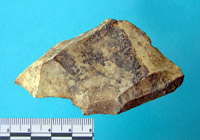
This dirty tool contained bits of sotol and yucca epidermis, plant fibers, phytoliths, and starch grains; all indicate its use to cut the leaves from desert succulents. TAMU Anthropology archives. |
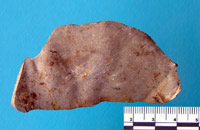
Fibers and epidermis fragments adhering to the edge of this tool indicate its use was to scrape the tissue from yucca plant leaves. TAMU Anthropology archives. |
| |
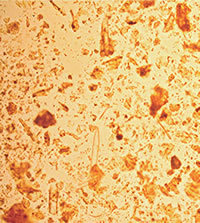
This microscopic "midden" of plant residue from a dirty tool contained phytoliths, starch grains, and plant fibers.
TAMU Anthropology archives. |
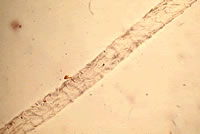
Lagomorph (jackrabbit) hair from a dirty tool such as a dirty flake. TAMU Anthropology archives. |
| |
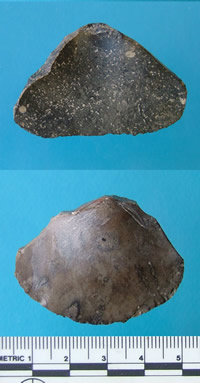
Sequent flake knife blades Area G Analysis Unit 8. These tools were ulu-style knife blades used to cut the leaves from desert succulents and butcher animals.
TAMU Anthropology archives. |
|